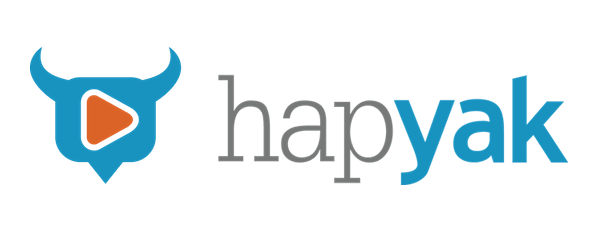Tell us about your role and journey into technology. What galvanized you to start HapYak?
I’ve been involved in groundbreaking technology since the search engine wars of the last millennium. Throughout my career, I’ve worked with startups leveraging technology to solve bigger and bigger problems by connecting people and content in new ways through search, mobile devices, and video. I love video most of all because it’s the most “human” of all the technologies. The goal of video is to help people effectively communicate, and surprisingly, there’s a long way to go for most businesses to reach that goal. I started HapYak to help close the gap between the technology and the people who use it to communicate.
What differentiates HapYak from the rest in the video technology landscape?
At HapYak, we’re focused on the big picture of how video is transforming communications, and have built a platform to facilitate that change. By balancing ease of use, tight integrations and unlimited flexibility, we uniquely empower our customers to rely on us as a single-source solution across dozens of use-cases.
How do you prepare for the highly disruptive video marketing technology ecosystem?
We listen to our customers. We listen to end-users. We dig into the data to discover non-obvious patterns that can inform us about product direction. The only constant in technology is change and we approach every decision with that in mind. All of our customers face disruption at some level in their own markets, or within the tech stack they’ve deployed. By designing our platform, fundamentally, on web technologies we’re able to adapt and help our customers adapt, as fast as the web itself.
What is the true context of delivering relevant, real-time personalization with interactive video?
It’s helpful to think of interactive video as a conversation. In a conversation, if you ask a question, you expect a response. Once you give a response, you expect the other person to react or adapt. That’s what “real-time personalization” means to me. If you’re watching a video from a company that “knows you,” the video should acknowledge this familiarity. Furthermore, the video should ask you how it can help you. When the viewer responds, an interactive video will react with some sort of feedback. There are many types of conversations that will necessitate different types of features, but an interactive video approach should feel the same as a conversation.
What are the biggest challenges for video marketing teams in delivering better messages to audiences?
Lack of feedback and actionable data is the most consistent barrier to improving user experience. In video marketing, there is a tremendous amount of good advice about what types of videos to create, how long they should be, if you should use animated scenarios or live action, etc. — but after making the investment in production, the question remains, “Was it worth it?” Integrating video metrics like total play-starts or completion-rate into your marketing automation platform is better than nothing, but not very instructive on how to hone your message. The real challenge is knowing “What was the viewer interested in?” and “Did this video help them?”
How do you plan to further expand the role of interactive videos into sales journeys?
We will continue to provide the best platform on the market for gaining business insights through video. The video mega-trend shows no signs of slowing down, and the demand for more video and analytics only grows. I expect that HapYak’s role will expand in the sales journey quite naturally as companies turn away from one-off video experiments, and toward enterprise solutions and systems of record for critical business communications.
How do you leverage Automation and BI/Analytics tools in your work?
We use BI/Analytics tools to identify behavioral patterns that influence specific outcomes that matter to customers. For example, BI tools help us understand the best time, place and creative to use in order to maximize click-through rate. BI tools help us analyze the relationship between interaction patterns of returning users. We also understand how to maximize all measured outcomes across a library of videos using BI tools. Honestly, though, we’re still just scratching the surface of what’s possible as BI and analytics tools expand and mature.
Which marketing and sales automation tools and technologies do you currently use?
We use our own tools extensively to engage prospects. For example, personalized video communications to engage prospects and then integrate that data with Intercom, Salesforce, and Outreach.
How often do you measure the performance of your marketing analytics and sales reporting?
We review marketing performance monthly and sales reporting weekly.
What startups in the technology industry are you watching keenly right now?
I’m pretty interested in voice technology and in some of the advances in healthcare right now. For example, check out the platform that Orbita has created. Its approach mirrors my preference for “more human” technology. I’m intrigued by technology that adds value to human experience.
Could you tell us about an outstanding digital campaign?
Among our customers, I’ve seen some great Account-Based Marketing campaigns that have combined targeted emails with personalized video into highly effective campaigns. One, in particular, delivered an average video engagement of 83% in just the first run, secured 86 meetings that otherwise wouldn’t have been scheduled, and delivered over $200K in the pipeline from just one trial campaign. It was so successful the campaign became an ongoing program. It was the epitome of data in action for marketing campaigns. Ultimately, an outstanding campaign is about the integration and getting all of the pieces moving in the same direction, aligned to a well-articulated goal.
How do you prepare for an AI-centric world as a business leader?
When we speak with customers about AI and its potential, it’s mainly in relation to staffing issues. There is simply too much data, too few ‘big data’ analysts and too much esoteric process that gets in the way of data-driven improvements. The way to prepare for AI solutions is to identify where these conditions exist, examine, and create a good hypothesis for how to use data in optimizing outcomes. Like most problems of this nature, your teams already know and will be eager to tell you about it. In the next few years, and even today, AI is a buzzword for every solution we buy. Knowing which problems make sense for AI will help any business leader prepare.
How do you inspire your people to work with technology?
HapYak is lucky to be in a space that is inherently exciting. Millions of people watch interactive videos created on our platform every day and the team sees the impact. There is nothing more exciting than knowing you’re working hard on problems that matter. We regularly remind our teams about that impact.
One word that best describes how you work.
Thoughtfully.
What apps/software/tools can’t you live without?
This may be pretty old school (of the new school) but here it is: Google Drive, JIRA, Confluence, Handbrake, and Slack.
What’s your smartest work-related shortcut or productivity hack?
Checklists on whiteboards. Seriously, when dealing with so much complexity in technology, projects, and customers, having a big whiteboard with checklists of the most important things to do daily and weekly is my #1 productivity hack.
What are you currently reading?
For the last many years I’ve read only non-fiction, but recently I’ve really enjoyed some classic fiction to help me think about the future — both good and bad. I’m currently reading, The Diamond Age by Neil Stephenson. The last book I finished was World War Z by Max Brooks. I read 95% of everything in the Kindle app in my iPhone.
What’s the best advice you’ve ever received?
Chop wood. Draw water.
Something you do better than others – the secret of your success?
I can extrapolate quickly, switch thought streams quickly and slow it all down to work on deeply understanding as needed. I don’t know how unique that is, but it is how I get things done.
Tag the one person in the industry whose answers to these questions you would love to read:
Nate Treloar, CEO of Orbita.
Thank you, Kyle! That was fun and hope to see you back on MarTech Series soon.
Building on a distinguished career developing ground-breaking Web technologies, Kyle founded HapYak in 2012 to transform passive videos into more engaging experiences. In his role as Chief Product Officer he brings bold approaches to HapYak’s solution, enabling anyone to create interactive video and capture unique insights into user-level behavior.
A veteran of several successful start-ups, Kyle led product strategy at RAMP Video (acquired by Cxense), and held senior engineering roles at mobile advertising company, Third Screen Media, Internet applications pioneer WebOs and Secure-Bank, one of the first Internet credit card processors.
 Whether your business has one compelling video or a thousand, HapYak helps you turn them into clickable, shoppable, and trackable user experiences. With a secure interactivity layer delivered from the cloud, HapYak works with any video player, anywhere, to drive deeper user engagement, video analytics and monetization.
Whether your business has one compelling video or a thousand, HapYak helps you turn them into clickable, shoppable, and trackable user experiences. With a secure interactivity layer delivered from the cloud, HapYak works with any video player, anywhere, to drive deeper user engagement, video analytics and monetization.
Visit our Gallery at HapYak.com to see why the world’s most successful organizations rely on HapYak every day to enhance their video strategy with personalized data-driven experiences, in-video shopping, choose your own adventure, interactive learning and more.
The MTS Martech Interview Series is a fun Q&A style chat which we really enjoy doing with martech leaders. With inspiration from Lifehacker’s How I work interviews, the MarTech Series Interviews follows a two part format On Marketing Technology, and This Is How I Work. The format was chosen because when we decided to start an interview series with the biggest and brightest minds in martech – we wanted to get insight into two areas … one – their ideas on marketing tech and two – insights into the philosophy and methods that make these leaders tick.












Comments are closed.